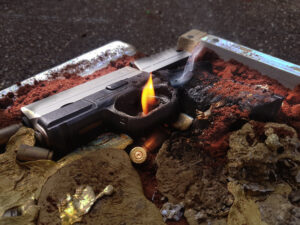In response to the Pulse Night Club Mass Shooting in Orlando, Florida, Argentinian-American artist Stephanie Mercedes melted a Sig Sauer MCX rifle (the exact model used during the shooting) to cast 49 “liberty bells” for the 49 individuals who lost their lives. Mercedes went on to melt guns and bullet casings into other musical instruments and sculptures such as harp strings, books, and gongs. She hopes this will open a dialogue about guns and violence in America. Mercedes also incorporates music and history into her art to tackle subjects like “The Disappeared” from the Argentine Dictatorship (1976-1983).


What you will learn:
- How, despite attending art school, her choice of profession and specialty within the arts was more heavily influenced by her childhood and family. (3:12-8:13)
- How, as a gay Latina, the Pulse Night Club shooting in Orlando personally affected her, how she used her skills as an artist to respond, and how that helped open up a different, more open dialogue about gun control issues. (8:13-15:42)
- Why she got involved with a programmed called Issue Voter (https://issuevoter.org) which uses art as a way to connect emotionally to those with opposing views and provide a way for all sides of the argument to have an open discussion. (15:42-21:14)
- How survivors and families of victims from the Pulse shooting have reacted to her work, and how she strives to involve all audiences in her work. (21:14-26:13)
- How she accomplishes such ambitious pieces and the precarious process of breaking down volatile objects like guns, bullets, and shell casings. Why metal and blacksmithing are a dying art and how she had to learn this craft from an unlikely source. (26:13-33:45)
- The benefit of having a team to help with her projects and the dangers involved in her work.
- How she has benefited from residencies, grants, and fellowships to help her make a living through art. (33:45-38:10)
- How she manages to effortlessly incorporate art and the law, and how she is currently opposing pending copyright legislation in an effort to preserve Argentinian history. (38:10-49:36)
- How people from opposite ends of the political spectrum react to her work and why art that approaches viewers viscerally, without making a political statement, can open pathways to dialogue that political discussions typically preclude. (49:36-57:08)
- Advice Mercedes has for young people aspiring to make a career in the arts. (57:08-1:05:56)
Resources Stephanie Mercedes:
Check This Out:
Light, Space and Interactive Technologies with Dylan Neuwirth
Talking with Internationally Acclaimed Painter Alfredo Arreguin
RECAP: Listener Reviews, Tracy Rector, What’s Next, and More
Painting Through Pain, with Hiba Jameel
